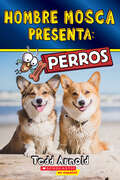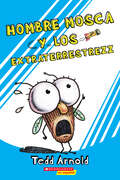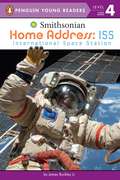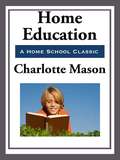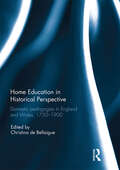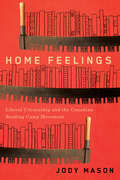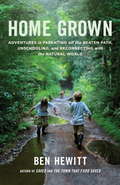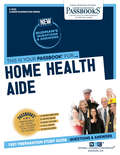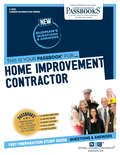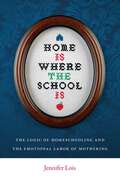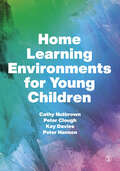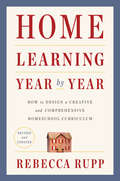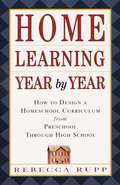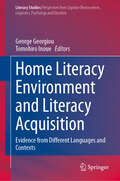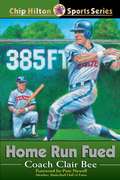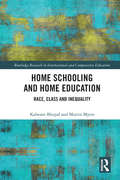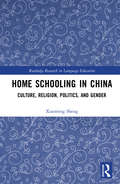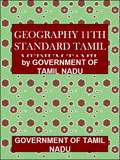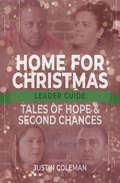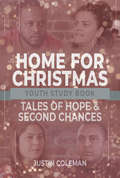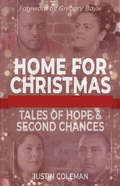- Table View
- List View
Hombre Mosca Presenta: Perros (Hombre Mosca presenta)
by Tedd ArnoldFly Guy is buzzing to learn all about dogs!¡Buzz y Hombre Mosca visitan una exposición canina donde lo aprenden todo sobre el mejor amigo del hombre! Ambos amigos exploran las diferentes razas de perro, perros famosos a lo largo de la historia, los trabajos que realizan los perros y mucho más.While visiting a dog show, Buzz and Fly Guy learn all about man's best friend! From exploring different breeds, to famous dogs throughout history, to learning all about working dogs and more, there's plenty for the best friends to explore.
Hombre Mosca y los extraterrestrezz (Hombre Mosca)
by Tedd ArnoldA hysterical, action-packed outer space adventure for Fly Guy and Buzz in the New York Times bestselling Fly Guy series.Buzz is making a movie about aliens from outer space. When the action begins, superheroes Fly Guy and Buzz Boy are protecting a secret fort in the sky when an alien ship captures them! The duo must outsmart the aliens and the space pirates with the help of Dragon Dude and Fly Girl. The fun-zee is never-ending in this early chapter book.Buzz esta haciendo una pelicula sobre extraterrestres. ¡Hombre Mosca y Buzz son los superheroes encargados de proteger un fuerte en el cielo cuando una nave espacial enemiga los captura! El duo tendra que escapar de los extraterrestres y de los piratas del espacio con la ayuda de algunos amigos. ¡Diviertete de principio a fin con este divertidisimo libro por capitulos!
Home Address: International Space Station (Smithsonian)
by James BuckleyHome is a long way from home!There are no refrigerators in space—think about it! Life on the International Space Station is well, another, way of life: you wake up in a sleeping bag tied to the wall; open a food package which keeps your meals from floating away, and then maybe go to work . . . walking in space! (And the toilet? That’s a story!) A lively reader about daily life on the ISS.
Home Education
by Charlotte MasonHome Education consists of six lectures by Charlotte Mason about the raising and educating of young children (up to the age of nine), for parents and teachers. She encourages us to spend a lot of time outdoors, immersed in nature, handling natural objects, and collecting experiences on which to base the rest of their education. She discusses the use of training in good habits such as attention, thinking, imagining, remembering, performing tasks with perfect execution, obedience, and truthfulness, to replace undesirable tendencies in children (and the adults that they grow into). She details how lessons in various school subjects can be done using her approach. She concludes with remarks about the Will, the Conscience, and the Divine Life in the Child. Charlotte Mason was a late nineteenth-century British educator whose ideas were far ahead of her time. She believed that children are born persons worthy of respect, rather than blank slates, and that it was better to feed their growing minds with living literature and vital ideas and knowledge, rather than dry facts and knowledge filtered and pre-digested by the teacher. Her method of education, still used by some private schools and many homeschooling families, is gentle and flexible, especially with younger children, and includes first-hand exposure to great and noble ideas through books in each school subject, conveying wonder and arousing curiosity, and through reflection upon great art, music, and poetry; nature observation as the primary means of early science teaching; use of manipulatives and real-life application to understand mathematical concepts and learning to reason, rather than rote memorization and working endless sums; and an emphasis on character and on cultivating and maintaining good personal habits. Schooling is teacher-directed, not child-led, but school time should be short enough to allow students free time to play and to pursue their own worthy interests such as handicrafts. Traditional Charlotte Mason schooling is firmly based on Christianity, although the method is also used successfully by secular families and families of other religions.
Home Education in Historical Perspective: Domestic pedagogies in England and Wales, 1750-1900
by Christina De BellaigueThis book is the first publication to devote serious attention to the history of home education from the late eighteenth to the early twentieth century. It brings together work by historians, literary scholars and current practitioners who shed new light on the history of home-schooling in the UK both as a practice and as a philosophy. The six historical case studies point to the significance of domestic instruction in the past, and uncover the ways in which changing family forms have affected understandings of the purpose, form and content of education. At the same time, they uncover the ways in which families and individuals adapted to the expansion of formalised schooling. The final article - by philosopher and Elective Home Education practitioner and theorist Richard Davies - uncovers the ways in which the historical analysis can illuminate our understanding of contemporary education. As a whole, the volume offers stimulating insights into the history of learning in the home, and into the relationship between families and educational practice, that raise new questions about the objectives, form and content of education in the past and today. This book was originally published as a special issue of the Oxford Review of Education.
Home Feelings: Liberal Citizenship and the Canadian Reading Camp Movement (Carleton Library Series)
by Jody MasonLiterature, literacy, and citizenship took on new and contested meanings in early twentieth-century Canada, particularly in frontier work camps. In this critical history of the reading camp movement, Jody Mason undertakes the first sustained analysis of the organization that became Frontier College in 1919. Employing an interdisciplinary approach, Home Feelings investigates how the reading camp movement used fiction, poetry, songs, newspapers, magazines, school readers, and English-as-a-second-language and citizenship manuals to encourage ideas of selfhood that were individual and intimate rather than collective. Mason shows that British-Canadian settlers' desire to define themselves in relation to an expanding non-British immigrant population, as well as a need for immigrant labour, put new pressure on the concept of citizenship in the first decades of the twentieth century. Through the Frontier College, one of the nation's earliest citizenship education programs emerged, drawing on literature's potential to nourish ""home feelings"" as a means of engaging socialist and communist print cultures and the non-British immigrant communities with which these were associated. Shifting the focus away from urban centres and postwar state narratives of citizenship, Home Feelings tracks the importance of reading projects and conceptions of literacy to the emergence of liberal citizenship in Canada prior to the Second World War.
Home Ground
by Debra Gwartney Barry LopezPublished to great acclaim in 2006, the hardcover edition of Home Ground: Language for an American Landscape met with outstanding reviews and strong sales, going into three printings. A language-lover's dream, Home Ground revitalized a descriptive language for the American landscape by combining geography, literature, and folklore in one volume. Now in paperback, this visionary reference is available to an entire new segment of readers. Home Ground brings together 45 poets and writers to create more than 850 original definitions for words that describe our lands and waters. The writers draw from careful research and their own distinctive stylistic, personal, and regional diversity to portray in bright, precise prose the striking complexity of the landscapes we inhabit. Home Ground includes 100 black-and-white line drawings by Molly O'Halloran and an introductory essay by Barry Lopez.
Home Ground
by Debra Gwartney Barry LopezPublished to great acclaim in 2006, the hardcover edition of Home Ground: Language for an American Landscape met with outstanding reviews and strong sales, going into three printings. A language-lover's dream, Home Ground revitalized a descriptive language for the American landscape by combining geography, literature, and folklore in one volume. Now in paperback, this visionary reference is available to an entire new segment of readers. Home Ground brings together 45 poets and writers to create more than 850 original definitions for words that describe our lands and waters. The writers draw from careful research and their own distinctive stylistic, personal, and regional diversity to portray in bright, precise prose the striking complexity of the landscapes we inhabit. Home Ground includes 100 black-and-white line drawings by Molly O'Halloran and an introductory essay by Barry Lopez.
Home Grown
by Ben HewittWhen Ben Hewitt and his wife bought a sprawling acreage of field and forest in northern Vermont, the landscape easily allowed them to envision the self-sustaining family farm they were eager to start. But over the years, the land became so much more than a building site; it became the birthplace of their two sons, the main source of family income and food, and ultimately, both classroom and home for their children. Having opted out of formal education, Hewitt's sons learn through self-directed play, exploration, and experimentation on their farm, in the woods, and (reluctantly) indoors. This approach has allowed the boys to develop confidence, resourcefulness, and creativity. They learn, they play, they read, they test boundaries, they challenge themselves, they fail, they recover. And these freedoms allow their innate personalities to flourish, further fueling growth and exploration. Living in tune with the natural world teaches us to reclaim our passion, curiosity, and connectivity. Hewitt shows us how small, mindful decisions about day-to-day life can lead to greater awareness of the world in your backyard and beyond. We are inspired to ask: What is the true meaning of "home" when the place a family lives is school, school system, and curriculum? When the parent is also the teacher, how do parenting decisions affect a child's learning? (And exactly how much trouble can a couple of curious boys gallivanting in the wild woods all day get into?) Home Grown reminds us that learning at any age is a lifelong process, and the best "education" is never confined to a classroom. These essays on nature, parenting, and education show us that big change can come from making small changes in how you live on the land, while building a life you love.
Home Health Aide: Passbooks Study Guide (Career Examination Series)
by National Learning CorporationThe Home Health Aide Passbook® prepares you for your test by allowing you to take practice exams in the subjects you need to study. It provides hundreds of questions and answers in the areas that will likely be covered on your upcoming exam.
Home Improvement Contractor: Passbooks Study Guide (Career Examination Series)
by National Learning CorporationThe Home Improvement Contractor Passbook® prepares you for your test by allowing you to take practice exams in the subjects you need to study. It provides hundreds of questions and answers in the areas that will likely be covered on your upcoming exam, including but not limited to: home improvement laws and regulations; general construction; safety; business, payroll and labor practices; and more.
Home Is Where the School Is: The Logic of Homeschooling and the Emotional Labor of Mothering
by Jennifer LoisExplores the experiences of homeschooling mothersMothers who homeschool their children constantly face judgmental questions about their choices, and yet the homeschooling movement continues to grow with an estimated 1.5 million American children now schooled at home. These children are largely taught by stay-at-home mothers who find that they must tightly manage their daily schedules to avoid burnout and maximize their relationships with their children, and that they must sustain a desire to sacrifice their independent selves for many years in order to savor the experience of motherhood. Home Is Where the School Is is the first comprehensive look into the lives of homeschooling mothers. Drawing on rich data collected through eight years of fieldwork and dozens of in-depth interviews, Jennifer Lois examines the intense effects of the emotional and temporal demands that homeschooling places on mothers’ lives, raising profound questions about the expectations of modern motherhood and the limits of parenting.
Home Learning Environments for Young Children
by Cathy Nutbrown Peter Clough Peter Hannon Kay DaviesBy bringing together research evidence on effectively supporting parents to engage with their children’s early learning, and the role of education professionals in developing partnerships with families, this book focuses on partnerships between professionals and parents to enhance family learning for young children in literacy and other aspects of early learning. The move towards setting, home-based, and online learning has accelerated, and it is important for both students and practitioners to value parents’ roles in their young children’s learning; to consider how parents can support young children’s learning in these scenarios, and how to apply this in practice with children aged birth to five. Through a wealth of case studies from real experience, the authors showcase an inspiring range of inclusive projects and approaches with families, including marginalised groups such as bilingual learners, fostering families, and families identified as ‘vulnerable’ including imprisoned fathers and children with specific learning needs.
Home Learning Environments for Young Children
by Cathy Nutbrown Peter Clough Peter Hannon Kay DaviesBy bringing together research evidence on effectively supporting parents to engage with their children’s early learning, and the role of education professionals in developing partnerships with families, this book focuses on partnerships between professionals and parents to enhance family learning for young children in literacy and other aspects of early learning. The move towards setting, home-based, and online learning has accelerated, and it is important for both students and practitioners to value parents’ roles in their young children’s learning; to consider how parents can support young children’s learning in these scenarios, and how to apply this in practice with children aged birth to five. Through a wealth of case studies from real experience, the authors showcase an inspiring range of inclusive projects and approaches with families, including marginalised groups such as bilingual learners, fostering families, and families identified as ‘vulnerable’ including imprisoned fathers and children with specific learning needs.
Home Learning Year by Year, Revised and Updated: How to Design a Creative and Comprehensive Homeschool Curriculum
by Rebecca RuppA comprehensive guide to designing homeschool curriculum, from one of the country&’s foremost homeschooling experts—now revised and updated! Homeschooling can be a tremendous gift to your children—a personalized educational experience tailored to each kid&’s interests, abilities, and learning styles. But what to teach, and when, and how? Especially for first-time homeschoolers, the prospect of tackling an annual curriculum can be daunting. In Home Learning Year by Year, Rebecca Rupp presents comprehensive plans from preschool through high school, covering integral subjects for each grade, with lists of topics commonly presented at each level, recommended resource and reading lists, and suggestions for creative alternative options and approaches. Included, along with all the educational basics, are techniques and resources for teaching everything from philosophy to engineering, as well as suggestions for dealing with such sensitive topics as sex education. Now revised throughout with all-new updates featuring the most effective and up-to-date methods and reading guides to homeschool your child at all ages, Home Learning Year by Year continues to be the definitive book for the homeschooling parent.
Home Learning Year by Year: How to Design a Homeschool Curriculum from Preschool Through High School
by Rebecca RuppFinally, homeschoolers have a comprehensive guide to designing a homeschool curriculum, from one of the country's foremost homeschooling experts. , Rebecca Rupp presents a structured plan to ensure that your children will learn what they need to know when they need to know it, from preschool through high school. Based on the traditional pre-K through 12th-grade structure,Home Learning Year by Yearfeatures: The integral subjects to be covered within each grade Standards for knowledge that should be acquired by your child at each level Recommended books to use as texts for every subject Guidelines for the importance of each topic: which knowledge is essential and which is best for more expansive study based on your child's personal interests Suggestions for how to sensitively approach less academic subjects, such as sex education and physical fitness From the Trade Paperback edition.
Home Literacy Environment and Literacy Acquisition: Evidence from Different Languages and Contexts (Literacy Studies #26)
by George Georgiou Tomohiro InoueThis book provides a comprehensive and up-to-date overview of the literature on home literacy environment and its association with literacy skills in different languages and contexts. Home literacy environment (HLE), an umbrella term that encompasses various activities parents engage in with their children, has been studied extensively by psychologists, linguists, behavioral geneticists, and educators. However, no systematic effort has been put into synthesizing this growing body of research in a coherent manner, making it difficult for researchers and various stakeholders to understand the key points of past research while keeping up with the latest research findings. To address this need, the first part of the book provides an overview of the current literature on conceptualizations of HLE, covering prominent theoretical models, the measurement of HLE, the potential extension and generalizability of models across contexts, the intersections between home learning environment in literacy, numeracy, and other domains, and the genetic and environmental etiology of literacy development The second section of the book hosts a wide variety of studies from all over the world, conducted in English-speaking countries (UK, U.S., Canada), Finland, Greece, Turkey, China, Japan, the Philippines and other Southeast Asian countries, and Chile and other Latin American and Caribbean countries, while it includes chapters with both typically-developing children and children at familial risk of dyslexia. The third section of this book offers a comprehensive collection of chapters on intervention studies examining the role of family literacy programs, dialogic reading, and onscreen digital access. Together, the 22 chapters of this book elucidate the complex nature of HLE and provide future research directions and instructional recommendations on how parents and policymakers can improve home literacy practices around the world. As such, this book is valuable for researchers, educators, and other professionals, and the readership ranges from graduate students and scholars to parents and policymakers.
Home Run Feud (Chip Hilton Sports Series #22)
by Clair BeeChip sees the morale of his baseball team threatened by the arrogant behavior of first baseman and heavy hitter Ben Green.
Home Schooling and Home Education: Race, Class and Inequality (Routledge Research in International and Comparative Education)
by Kalwant Bhopal Martin MyersHome Schooling and Home Education provides an original account of home education and examines ways in which the discourses of home education are understood and contextualised in different countries, such as the UK and USA. By exploring home education in the global and local context of traditional schooling, the book bridges a much-needed gap in educational and social scientific research. The authors explore home education from two related perspectives: firstly how and why home education is accessed by different social groups; and secondly, how these groups are perceived as home educators. The book draws upon empirical case study research with those who use home education to address issues of inequality, difference and inclusion, before offering suggestions for viable policy shifts in this area, as well as broadening understandings of risk and marginality. It engages and initiates debates about alternatives to the standard schooling model within a critical sociological context. The scholarly emphasis and original nature of Home Schooling and Home Education makes this essential reading for academics and postgraduate researchers in the fields of education and sociology, as well as for educational policymakers.
Home Schooling in China: Culture, Religion, Politics, and Gender (Routledge Research in Language Education)
by Xiaoming ShengHome Schooling in China seeks to provide a better understanding of the social movement of home schooling in China. In this book, the author addresses several major themes of home education, including marketization, social stratification, culture, religion, Confucianism, gender policy, gender, and home schooling. This book draws a broad attention to the in-depth information to the relationship of marketisation, social stratification, and home education in China. It offers an implication for a better understanding not only for influences of religion (e.g. Christianity) but also the effects of Confucianism on the growth of home education in China. With a strong theoretical foundation, the book comprehensively untangles the key possible factors that shape China’s social movement of home education. The book offers a background on theories and research methodology, as well as reports on empirical studies that analyse the influences of marketisation on home schooling, social stratification, and the development of home schooling. This book is ideal reading for academics, researchers, and postgraduate students in the fields of Confucianism, social class, gender, and education in China.
Home Science class 11 - Tamil Nadu Board
by Government Of Tamil NaduHome Science or the science of managing a home, includes a study of all aspects related to our home. It is a study that focuses on family members and the achievement of sat¬isfaction of each and every member through thoughtful effective and constructive use of resources. Home Science is both an “art and science”. This is because it teaches the art of using resources so that a harmonious whole is achieved and an overall pleasant effect is created. At the same time, it provides the scientific basis of techniques involved in making a home a happy healthy and beauti¬ful place to live in. For example, the subject Home Science imparts knowledge about the different food groups, the nutrients present in them, the causes of nutrient deficiency and the dietary management of various diseases. This is the ‘science’. However, the ability to prepare various recipes with required nutrients for a particular age group and serve it in a very attractive manner in a pleasant environment so as to motivate consumption of healthy foods and feeling of wellbeing is an ‘art’.
Home Science class 12 - Tamil Nadu Board: முகப்பு அறிவியல் வகுப்பு 12 - தமிழ்நாடு வாரியம்
by Government Of Tamil NaduHome Science or the science of managing a home, includes a study of all aspects related to our home. It is a study that focuses on family members and the achievement of sat¬isfaction of each and every member through thoughtful effective and constructive use of resources. Home Science is both an “art and science”. This is because it teaches the art of using resources so that a harmonious whole is achieved and an overall pleasant effect is created. At the same time, it provides the scientific basis of techniques involved in making a home a happy healthy and beauti¬ful place to live in. For example, the subject Home Science imparts knowledge about the different food groups, the nutrients present in them, the causes of nutrient deficiency and the dietary management of various diseases. This is the ‘science’. However, the ability to prepare various recipes with required nutrients for a particular age group and serve it in a very attractive manner in a pleasant environment so as to motivate consumption of healthy foods and feeling of wellbeing is an ‘art’.
Home for Christmas Leader Guide: Tales of Hope and Second Chances (Home for Christmas)
by Justin ColemanHome for Christmas brings inspiring stories of hope and second chances into the Advent season. Author and pastor Justin Coleman matches real life stories of struggle and triumph to the Advent themes of hope, love, joy, and peace to show how the light of Christmas shines brightly even in hard times. Each chapter lifts up a scripture reflection alongside tales of men and women who reflect on the Advent themes with love and longing. Throughout each of the four chapters and the accompanying DVD for a small-group experience, Coleman captures the stories of formerly incarcerated men and women as they find work and opportunity through Homeboy Industries in Los Angeles, California. These men and women share their memories and experiences in light of the hope and new life they’ve experienced at Homeboy. Additional components for this four-week study include a comprehensive Leader Guide and a DVD featuring author and pastor Justin Coleman.
Home for Christmas Youth Study Book: Tales of Hope and Second Chances (Home for Christmas)
by Justin ColemanHome for Christmas brings inspiring stories of hope and second chances into the Advent season. Author and pastor Justin Coleman matches real life stories of struggle and triumph to the Advent themes of hope, love, joy, and peace to show how the light of Christmas shines brightly even in hard times. Each chapter lifts up a scripture reflection alongside tales of men and women who reflect on the Advent themes with love and longing. Throughout each of the four chapters and the accompanying DVD for a small-group experience, Coleman captures the stories of formerly incarcerated men and women as they find work and opportunity through Homeboy Industries in Los Angeles, California. These men and women share their holiday memories and experiences in light of the hope and new life they’ve experienced at Homeboy. This Youth Study Book takes the ideas presented in the book and interprets them for young people grades 6-12.
Home for Christmas: Tales of Hope and Second Chances (Home for Christmas)
by Justin ColemanHome for Christmas brings inspiring stories of hope and second chances into the Advent season. Author and pastor Justin Coleman matches real life stories of struggle and triumph to the Advent themes of hope, love, joy, and peace to show how the light of Christmas shines brightly even in hard times. Each chapter lifts up a scripture reflection alongside tales of men and women who reflect on the Advent themes with love and longing. Throughout each of the four chapters and the accompanying DVD for a small-group experience, Coleman captures the stories of formerly incarcerated men and women as they find work and opportunity through Homeboy Industries in Los Angeles, California. These men and women share their holiday memories and experiences in light of the hope and new life they’ve experienced at Homeboy. Forward by Father Gregory Boyle. Additional components for this four-week study include a comprehensive Leader Guide and a DVD featuring author and pastor Justin Coleman.
